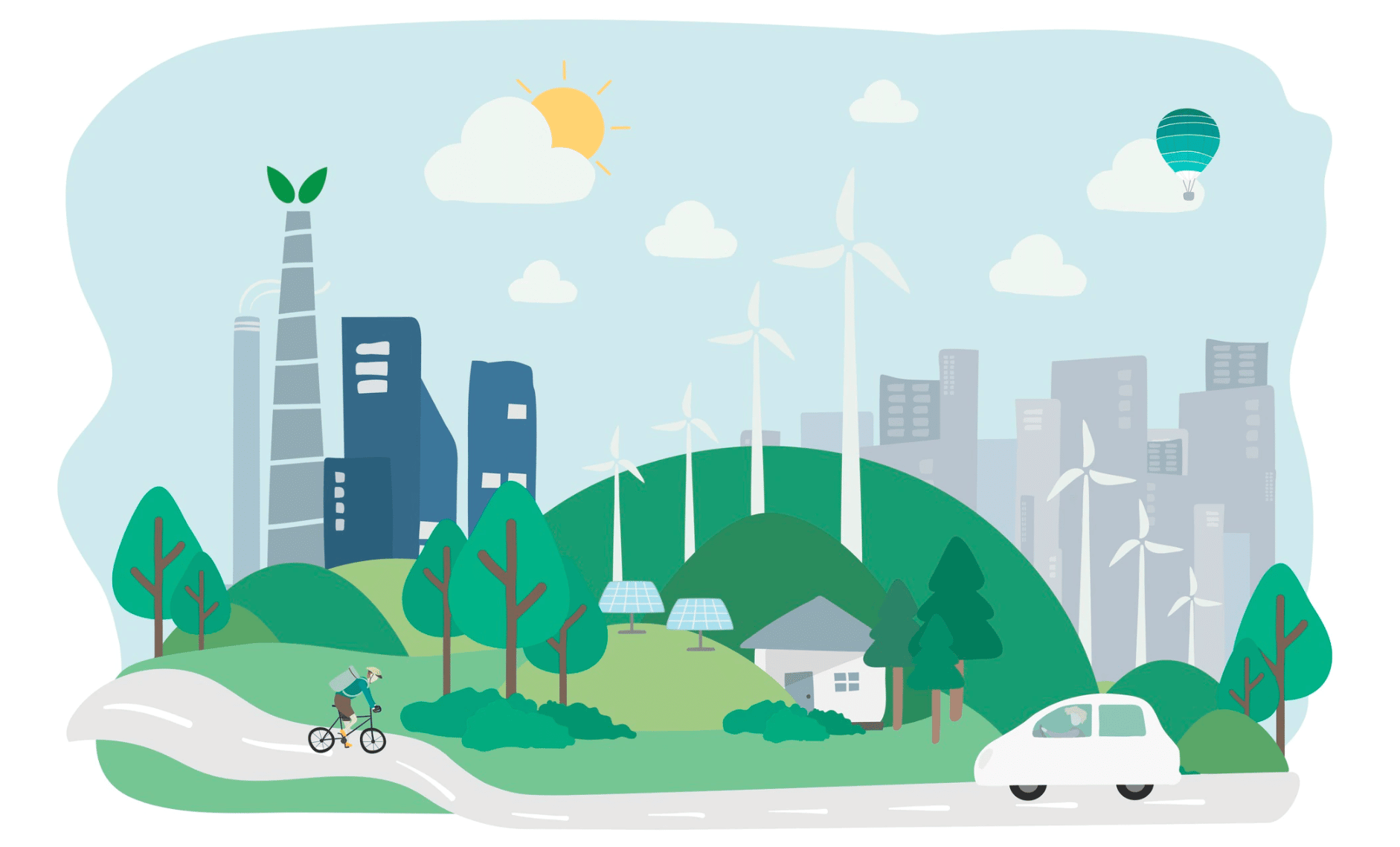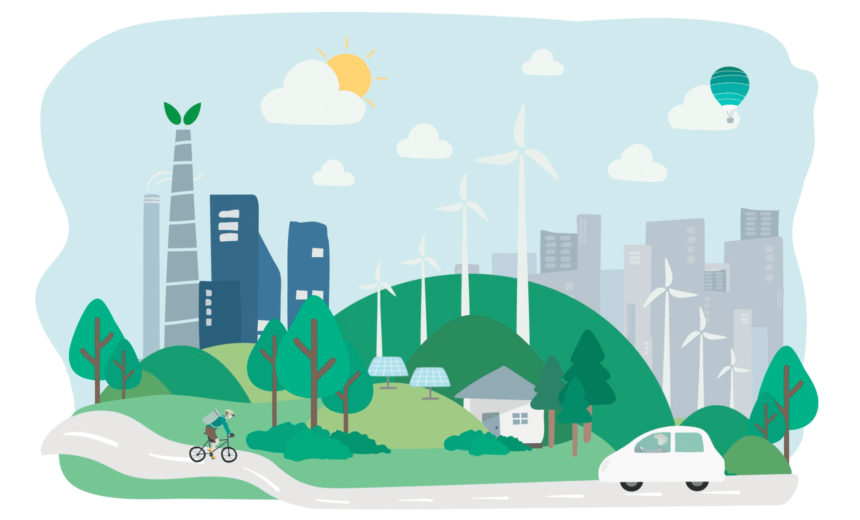
Introduction
The future is filled with uncertainties. What will the job market look like? Will global warming be under control? How will cities adapt to the changing world? Science fiction stories like “City of Bits” may have given us a glimpse of what’s to come.
One solution that aims to tackle these issues is the idea of a smart city. If the future holds smart cities, that must mean our current cities are dumb ones. This comprehensive guide will compare and contrast smart cities with regular cities. We’ll delve into what sets them apart and the benefits they offer.
By the end, you’ll have a better understanding of this concept and how it could shape our cities of the future.
Table of contents
What Is A Smart City?
A smart city is one that uses technology and data to improve the quality of life for its citizens. The conscious and agreed-upon decision includes areas like transportation, energy, education, healthcare, and public services. Data collected from various sources (such as traffic sensors or utility meters) is analyzed to gain insights and make decisions on improving these systems.
The ultimate goal of the smart city concept is to be more efficient, sustainable, and livable. It’s not just about flashy new tech but using technology to address real problems and improve the functioning of a city on a day-to-day basis. There are already smart cities all over the world, which we’ll explore in more detail later in this post.
Additionally, smart cities place heavy emphasis on artificial intelligence (AI), the Internet of Things (IoT), and big data. These components work together to collect, analyze, and utilize information in decision-making processes.
What Is A Dumb City?
The term “dumb city” is colloquial and not necessarily a technical definition. It can refer to a city that lacks the application of innovation. In terms of sustainability, a dumb city may have outdated systems and be behind in efforts toward becoming eco-friendly. The reality is that technology is moving fast. Faster than many cities can keep up with.
The government is responsible for the infrastructure and city services that make up daily life. In a dumb city, these systems may not be integrated or efficient. They may also lack transparency and involve ineffective decision-making processes. Essentially, a dumb city is one that hasn’t fully embraced the benefits of technology for improving city functions.
However, it’s important to understand that the word dumb doesn’t mean a city is terrible. Sometimes, investing in smart technology may not make sense for a rural or smaller city. It all depends on the specific needs and priorities of that city. Available private sector funds may also influence the capacity to go smart.
Sustainable Strategies: Smart City vs. Dumb City
In order to get a clearer picture of the difference between smart and dumb cities, let’s look at their approaches toward sustainability. Sustainability is a crucial component of smart cities. It prevents resource depletion and addresses issues like climate change. Plus, it takes a holistic approach to leave future generations a healthy, functioning city.
Also Read: What are smart cities?
AI-Driven City Planning
The smart city concept isn’t new by any means, but it has been gaining traction in recent years. That’s largely due to advancements in technology, specifically AI. The potential for AI in city planning and management is huge. Urban design requires making numerous decisions and predicting future outcomes. AI can assist with this by providing data-driven insights.
Smart cities use AI to gather and analyze information on various aspects of city cultures, such as access inside city centers or traffic patterns. It allows for more efficient application and decision-making. Additionally, it can improve the daily functioning of a city by identifying and addressing problems in real-time.
Another important aspect is the use of AI in public safety. Some cities are more prone to natural disasters than others. Whether it be wildfires, flooding, or earthquakes, AI can aid in predicting and preparing for these events. It can also calculate zones at risk and plan evacuation routes for maximum efficiency and safety.
Better and Efficient Energy Planning
Energy resources are limited, so it’s important to use them efficiently. Smart cities prioritize sustainable energy sources and utilize technology to monitor usage. It enables better management and allocation of resources, resulting in an equitable city. For example, smart cities may use technology to adjust energy usage based on peak times.
Additionally, it’s not just about using sustainable sources like solar and wind power. Smart cities also aim to decrease overall energy consumption by implementing efficient systems. That includes smart grids, buildings, and technologies such as LED lighting and electric vehicles.
Smart grids, which use digital technology to improve the electricity network, are becoming more common in smart cities. They provide benefits like better monitoring from energy management companies. Also, we could see reduced blackouts and the integration of renewable energy sources.
In a dumb city, there may be little focus on sustainable energy and inefficient resource usage. This lack of care can result in higher emissions and a greater environmental strain.
Also Read: AI and Power Grids.
Smart Homes and Buildings Contributing Towards Sustainability
The vast majority of homes worldwide are still considered “dumb.” They don’t have many advantages over homes from decades ago regarding sustainability.
In smart cities, homes and buildings have features like programmable thermostats and smart meters. These allow for better monitoring and control of energy usage. Additionally, they often incorporate renewable energy sources like solar panels. But even before a resident moves in, smart cities prioritize sustainable construction and green building standards.
For example, materials used in construction may be recycled or locally sourced. The building’s design also contributes to energy efficiencies, such as natural lighting and insulation. We might also see features like green roofs, which have added benefits like reducing heat and improving air quality.
Smarter Infrastructure
Infrastructure is a crucial component of city planning and development in cities. It encompasses everything from transportation to communication technology. In a dumb city, there may be little consideration for sustainability in infrastructure projects. That means a heavier reliance on non-renewable energy sources and potentially harmful materials.
In contrast, smart cities prioritize sustainable infrastructure. Everything is built with the future in mind, incorporating new technologies for efficiency and sustainability. Smart cities also prioritize high-speed internet access and the implementation of 5G networks in a public space. This allows for better communication and connectivity, improving the everyday functioning of a city.
But perhaps most importantly, smart cities prioritize sustainable transportation.
Smarter Traffic Management
Traffic is a common issue in big cities. It leads to pollution and wasted time. In a dumb city, there may not be efficient solutions for traffic management. You might see congested roads, limited public transportation options, and a lack of bike lanes or walking paths.
On the other hand, smart cities use technology to monitor and improve traffic flow. AI-powered traffic systems can analyze data and provide insights for better planning and decision-making. We could also see the Internet of Things (IoT) being used in a big way. Vehicles could communicate with each other and traffic lights to optimize traffic patterns.
According to the Daily Energy Insider, smart street lights could save millions in electricity costs every year. Additionally, smart cities prioritize alternative modes of transportation like public transit, biking, and walking. This helps to reduce pollution and improve the overall functioning of the city.
Another way that smart cities tackle traffic issues is through the concept of smart mobility. It includes a partnership between citizens with car-sharing programs and ride sharing apps, which can decrease the number of vehicles on the road. Smart parking systems are also great. They help drivers find available spots, reducing emissions from congestion and unnecessary circling.
Also Read: AI in Traffic Management
Smarter Water Management
Water is a precious resource, yet it is wasted and polluted in many cities. Smart cities prioritize sustainable water management. They use smart technology to monitor usage and detect leaks. It also means implementing recycling systems for wastewater.
There is also a focus on reducing pollution in waterways and utilizing green infrastructures, such as rain gardens and permeable pavement. All of these efforts work towards ensuring a clean and sustainable water supply for the city’s residents.
AI and IoT technology can play a vital role in smart cities’ water management strategies. But just as important is smart community initiatives and engagement to promote sustainable habits.
Better Air Quality
Things like smog, fumes from vehicles, and industrial pollution can greatly impact air quality. The emission of harmful pollutants in a public space often worsens in cities, leading to negative consequences for the environment and public health. It may even lead to higher rates of respiratory illnesses.
In a dumb city, little effort may be made to address and improve air quality. Smart cities prioritize clean air through measures like implementing strict emissions standards. They also spend resources promoting alternative modes of transportation.
Identifying and addressing pollution sources is key to improving air quality. The smart city strategy can also leverage AI and sensor technology to monitor air quality. It informs residents about the current conditions. These efforts work towards creating a healthier and more sustainable environment for city residents.
Smarter Waste Management
Smart city technology takes care of everything. From the glamorous to the mundane, like waste, it’s all accounted for. We’ve all seen horror stories of overflowing landfills, illegal dumping, and pollution from waste. That’s because waste management is often very low on the decision tree of dumb cities.
Smart cities prioritize sustainable waste management through strategies like increasing recycling efforts. They may also attack the problem’s source and find alternative packaging materials. Once again, AI technology can monitor and track waste to ensure an efficient disposal. We could dispatch teams before trash piles up, reducing health and environmental hazards.
The result is a cleaner-looking city and a more sustainable approach to waste management. It would also reduce waste disposal costs and improve the city’s overall functioning.
Smarter Roads
Since flying cars aren’t quite a reality yet, we rely on roads for transportation. Besides traffic management, there are plenty of ways a smart city outshines a dumb one when it comes to roads.
First of all, smart cities use technology to monitor and maintain road conditions. This can include everything from pothole detection to snow removal. Plus, with the arrival of electric cars, future cities are also preparing for the future by implementing charging stations for these vehicles.
An even smarter city would even have chargers on the road itself, using solar energy to power vehicles as they drive. Can you imagine a world without gas stations? There are currently a handful of European cities testing this technology, and it may not be long before we see it outside of the private sector.
In short, an underground charging pad set below the road surface can wirelessly charge electric vehicles as they pass over it. It could eventually make the process more convenient for drivers, although it is currently aimed at taxis, buses, and delivery trucks that travel longer distances and require more frequent charging.
Smarter Public Transportation
Public transportation is often underfunded and neglected in a dumb city. It’s even regarded as a lesser option, with the focus remaining on individual car ownership. People don’t want to take the bus simply because it’s not seen as a desirable choice.
In a smart city concept, public transportation is made more efficient and enjoyable for residents. This includes things like real-time updates on arrival times, convenient payment options, and comfortable amenities. From on-board wi-fi to spacious seating, future cities prioritize the needs and wants of public transportation users.
Everyone’s safety could be increased by installing breathalyzers on buses, preventing drunk drivers from getting behind the wheel. Camera systems on trains and buses can also aid in crime prevention.
Also Read: Role of artificial intelligence in transportation.
Smarter Green Corridors
A green corridor is an area designated for the preservation and growth of plants and wildlife. Moreover, it connects natural habitats and human settlements, creating a healthier environment for all. For example, a green corridor could connect a city park to a forest preserve outside of town.
Many green corridors are destroyed due to urban sprawl and development in dumb cities. However, a smart city looks towards the future by promoting green public space and protecting it from destruction. Future cities may use technology like drones to monitor green corridors and ensure they are well-maintained.
Integrating green corridors into town is currently the biggest challenge. But with the help of smart city technology, smart growth can result in green corridors incorporated into urban development.
Smarter Integrations Of Parks in the City
In a similar vein, smart cities prioritize green growth within the city itself. Taking things one step further, they may even install smarter technology within these parks.
For example, smart park benches can offer charging ports for electronic devices and even air purification systems. Sensors in the grass can monitor foot traffic and water levels to ensure optimal maintenance. And interactive screens may provide information about the plants and wildlife in the area.
Parks can also come in the form of “living buildings,” where plants and greenery cover the exterior to improve air quality and create a more enjoyable environment. Whether it’s a rooftop garden or a vertical forest, future cities are finding innovative ways to integrate nature into their urban landscapes.
Smarter Rain Water Harvesting
Recycling and conserving water is a must in a smart city. One way they do this is through rainwater harvesting. Smart cities can use technology to track weather patterns and predict when it will rain. It allows them to prepare for and maximize the collection of rainwater. Officials can then use the collected water for various purposes.
It could irrigate parks and green spaces, reducing the need for excess water usage. We could also use it to clean streets and flush toilets in public buildings. If a filtering system is in place, it could even be used for drinking water. Once that water is in the system, AI-powered software can monitor and distribute it efficiently.
AI in Smart Cities: Deep Integration of Sustainable Strategies
All the above examples are just a glimpse into using smart city technology for sustainable strategies. A smart, equitable city brings together various departments and industries to work towards a common goal. Whether it’s preserving the environment or improving city cultures.
AI allows for deep integration of these sustainable strategies by analyzing data and offering solutions. Machine learning, which is a type of AI, can even improve upon these solutions over time. It works by collecting data, recognizing patterns, and improving processes. Essentially, ML is a brain that never stops learning and evolving.
City services will use AI to monitor air quality, traffic flow, energy consumption, and more. With this important information, they can adjust and optimize sustainable strategies. Smart cities are constantly adapting and improving for the good of the community and the environment.
Prediction is also a big aspect of AI in smart cities. By analyzing data, AI can predict future needs and problems, allowing city planners to prepare for them. As such, we can finally say goodbye to inefficient trial and error or lack of budget. Future cities will be prepared and ready to face the challenges of tomorrow. And that’s true sustainability.
Also Read: Books: Artificial Intelligence and Smart Cities.
Examples of Smart Cities
Amsterdam, Netherlands
The Amsterdam Smart City project was launched in 2009 with a mission to make Amsterdam “the smartest region in the world.”
They have implemented various sustainable strategies, such as using smart grids to optimize energy usage and using data to improve transportation. With homes in the area accounting for one-third of the city’s carbon emissions, Amsterdam is also focusing on making its buildings more energy efficient. Smart meters are installed in buildings to track energy usage.
They also used the Internet of Things to establish iBeacons, a 3400-meter network using LPWA communication technology. These iBeacons transmit small packets of data through low-frequency radio waves to provide location-specific information to residents and visitors. IoT is also the main actor behind SmartFlow. The smart traffic system collects data from various sources, such as traffic lights and road sensors, to improve traffic flow and reduce congestion.
It also helps with parking, reducing the time to find a spot by up to 43%, and providing real-time information on available spots.
Songdo, South Korea
Songdo makes an interesting case as it was designed from the ground up as a smart city. Now considered one of the most advanced smart cities in the world, Songdo boasts a high-tech transportation system, buildings with sustainable features, and strong connectivity. Green spaces are also a priority, with over 40% of the city dedicated to parks and waterways.
One notable feature is the Central Park district. The 40-acre park is home to several green buildings, including LEED-certified structures and underground structures to collect rainwater for use.
Masdar City, UAE
An oasis in the middle of the desert, Masdar City is a model for sustainable living and clean energy technology. The city was built from the ground up to produce zero emissions and zero waste. It’s a pretty ambitious goal, and they’re well on their way to achieving it.
Masdar City utilizes solar energy for power and the famous cool breeze from the desert to keep the city cool. Its design incorporates traditional elements, such as narrow streets and a central plaza, to promote natural cooling. The buildings are also designed for maximum energy efficiency and the use of renewable energy. From glass to terracotta, materials are locally sourced and sustainable.
As for public transportation, Masdar City has electric vehicles and a personal rapid transit system. The PRT is a network of autonomous pods that can transport people to their destinations on demand.
Conclusion
Smart cities offer a solution to the challenges of urban areas. By using technology and data, they can improve sustainability and efficiency while also enhancing daily life for residents. From Woven City to Masdar, several successful smart cities are already in operation. And many more are on their way to becoming future leaders in sustainable living.
We must continue innovating and improving current smart city strategies to address the urgent challenges facing our cities and planet. As more and more people move towards urban areas, it’s crucial that we develop electronic spaces to ensure a bright future for our cities.
Are you living in a smart city? What kinds of sustainable measures are being implemented?
Source: YouTube
References
Boffey, Daniel. “World’s First Electrified Road for Charging Vehicles Opens in Sweden.” The Guardian, 12 Apr. 2018, https://www.theguardian.com/environment/2018/apr/12/worlds-first-electrified-road-for-charging-vehicles-opens-in-sweden. Accessed 15 Feb. 2023.
Carey, Liz. “Home.” Daily Energy Insider, 24 Apr. 2018, https://dailyenergyinsider.com/featured/12031-collaboration-utilities-seen-first-step-growth-smart-cities/. Accessed 15 Feb. 2023.
Cinema, Real Life. “Songdo: Go Inside The City Of The Future.” YouTube, Video, 10 Nov. 2018, https://www.youtube.com/watch?v=3ZKtr7vU5cI. Accessed 15 Feb. 2023.
City, Amsterdam Smart. “5 New Amsterdam Smart City Projects.” YouTube, Video, 5 Jan. 2011, https://www.youtube.com/watch?v=NiXTpLpmVhg. Accessed 15 Feb. 2023.
—. “Home.” Amsterdam Smart City, https://amsterdamsmartcity.com/. Accessed 15 Feb. 2023.
Hutton, Mercedes. “Sustainable and Smart: South Korea’s Songdo Offers Green Spaces and Good Schools.” Mansion Global, 21 Aug. 2021, https://www.mansionglobal.com/articles/sustainable-and-smart-south-koreas-songdo-offers-green-spaces-and-good-schools-228684. Accessed 15 Feb. 2023.
International, Cnbc. “What Is a Smart City?” YouTube, Video, 8 Feb. 2017, https://www.youtube.com/watch?v=bANfnYDTzxE. Accessed 15 Feb. 2023.
“Masdar City.” A Thriving Sustainable City In UAE’s Desert, https://www.blackridgeresearch.com/project-profiles/masdar-city-the-model-of-innovation-and-sustainability-in-abu-dhabi. Accessed 15 Feb. 2023.
Shift, DW. “Smart City: How Do You Live in a Smart City?” YouTube, Video, 22 Oct. 2019, https://www.youtube.com/watch?v=VRRPy-yEKRM. Accessed 15 Feb. 2023.
Show, Fully Charged. “Sustainable City.” YouTube, Video, 17 Mar. 2017, https://www.youtube.com/watch?v=WCKz8ykyI2E&t=125s. Accessed 15 Feb. 2023.
Tech, Mind Blowing. “Masdar City – World’s Most Sustainable Urban Communities, a Low-Carbon Development Made Up.” YouTube, Video, 9 Mar. 2021, https://www.youtube.com/watch?v=EN0kn5FWIBQ. Accessed 15 Feb. 2023.
“Toyota Woven City.” Toyota Woven City, https://www.woven-city.global/. Accessed 15 Feb. 2023.











